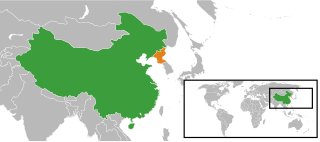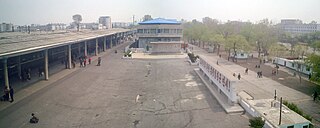Related Research Articles
An estimated 84,532 South Koreans were taken to North Korea during the Korean War. In addition, South Korean statistics claim that, since the Korean Armistice Agreement in 1953, about 3,800 people have been abducted by North Korea, 489 of whom were still being held in 2006.
The Current Population Survey (CPS) is a monthly survey of about 60,000 U.S. households conducted by the United States Census Bureau for the Bureau of Labor Statistics (BLS). The BLS uses the data to publish reports early each month called the Employment Situation. This report provides estimates of the unemployment rate and the numbers of employed and unemployed people in the United States based on the CPS. A readable Employment Situation Summary is provided monthly. Annual estimates include employment and unemployment in large metropolitan areas. Researchers can use some CPS microdata to investigate these or other topics.

A migrant worker is a person who migrates within a home country or outside it to pursue work. Migrant workers usually do not have an intention to stay permanently in the country or region in which they work.
People defect from North Korea for political, material, and personal reasons. Defectors flee to various countries, mainly South Korea. In South Korea, they are referred to by several terms, including "northern refugees" and "new settlers".
Graduate unemployment, or educated unemployment, is unemployment among people with an academic degree.

Filipinos in South Korea have a history dating back to the establishment of South Korea. Many live in Seoul, where they gather in the Hyehwa-dong and Dongsung-dong areas of Jongno-gu.

North Koreans in Russia consist mainly of three groups: international students, guest workers, and defectors and refugees. A 2006 study by Kyung Hee University estimated their total population at roughly 10,000.
Internal migration in the People's Republic of China is one of the most extensive in the world according to the International Labour Organization. This is because migrants in China are commonly members of a floating population, which refers primarily to migrants in China without local household registration status through the Chinese Hukou system. In general, rural-urban migrants are most excluded from local educational resources, citywide social welfare programs and many jobs because of their lack of hukou status. Migrant workers are not necessarily rural workers; they can simply be people living in urban areas with rural household registration.

The bilateral relations between the People's Republic of China (PRC) and the Democratic People's Republic of Korea (DPRK) have been generally friendly, although they have been somewhat strained in recent years because of North Korea's nuclear program. They have a close special relationship. China and North Korea have a mutual aid and co-operation treaty, signed in 1961, which is currently the only defense treaty China has with any nation. China's relationship with North Korea is its only formal alliance.
Durihana North Korea Mission is a defector aid Christian organization based in South Korea, founded by Pastor Chun Ki-won. The organization assists North Korean defectors escape from North Korea and China, often by helping refugees to pay their "brokers" fee, which allows them to cross borders. The group also provides migrants with temporary hideouts and helps them move to more secure areas. Durihana has been recognized as one of the main South Korean NGOs involved in aiding North Korean defectors in China.

In South Korea, immigration policy is handled by the immigration services of the Ministry of Justice, Ministry of Labor, Ministry of Health and Welfare and the Ministry of Foreign Affairs and Trade. The Nationality Act, Immigration Control Act, Multicultural Families Support Act, and the Framework Act on Treatment of Foreigners are the foundations of immigration policy in Korea. The Korean government initiated a discussion in 2003 on establishing an independent immigration office to accommodate fast-growing immigrant and to prepare inclusive and rational immigration policies; however, there has been little progress. The Foreigner Policy Committee, headed by the Prime Minister, coordinates foreigner-related policies which were handled by many ministries. However, its role is limited because of a shortage of resources and manpower. The establishment of an Immigration Office is expected to solve these problems by concentrating all related resources and manpower under one umbrella.

Youth unemployment refers to unemployment in young people, usually defined as those aged 15 - 24.

Saejowi (Korean: 새조위), also known as Saejowi Initiative for National Integration, operates in Seoul, South Korea, as a nongovernmental organization (NGO) that assists North Korean defectors with settlement in South Korea. Saejowi sponsors programs that provide medical support, job training, and other educational opportunities in order to aid with defector adjustment to South Korean society. Additionally, Saejowi works to encourage civil involvement in the Korean reunification movement, especially among the defector community. The organization hosts programs that facilitate open communication between South Koreans and defectors from North Korea. It has previously worked with the Korean Ministry of Unification, Korea Hana Foundation, and the Community Chest of Korea.
Thailand has become one of the destinations of choice for North Korean defectors aiming to either resettle in third countries, or pass in transit to South Korea. Although the Royal Thai Government does not recognize North Korean escapees as refugees, but rather as illegal economic migrants, the Thai government allows North Koreans illegally entering the country to resettle in South Korea. This is possible because South Korea’s domestic law recognizes that North Koreans are also citizens of South Korea. The Thai government also cites the "conveniently blurred geographical distinctions" between the two Koreas in facilitating the transfer and resettlement process.

Jangmadang are North Korean local markets, farmers' markets, black markets and bazaars. Since the North Korean famine in the 1990s, they have formed a large informal economy, and the government has become more lenient towards them. However, merchants still face heavy regulations. A majority of North Koreans have become dependent on jangmadang for their survival.
The rate of youth unemployment in South Korea fluctuated in the 9–11% range between 2001 and 2014. It was above 10% in 2018 and down to 7.1% by the end of 2019 - the lowest level since 2011.

The unemployment rate in the Republic of Korea as of December 2021 is 3.7 percent. Since its rapid globalization and democratization, the unemployment rate has been comparatively low compared to most OECD countries. This remains the case as of 2021. Being Asia’s fourth-largest economy, the country's booming exports have helped to maintain the unemployment rate very low by the standards of developed countries. There are several measurement differences between the standard of measurement set by the International Labour Organisation and the official measurement of unemployment in the Republic of Korea, set by Statistics Korea, that contribute to an inflated unemployment rate when compared to other countries that abide more strictly by the standard set by the International Labour Organisation.
Immigration to North Korea occurs when Koreans and others move to North Korea and make it their permanent home. Often this is considered a defection because these immigrants have, in the terms of the Cold War, switched allegiance. This group is in contrast to the much larger group of North Korean defectors who have left North Korea.

The COVID-19 pandemic has impacted migrants throughout the globe. Low-skilled migrants, refugees, and internally-displaced migrants are at a higher risk of contracting the virus. The pandemic has also aggravated the dangers of already-dangerous migration routes. Since the outbreak of COVID-19, international organizations have recorded a spike in human rights abuses suffered by migrants, especially in Africa, Latin America, and Asia. The restrictions on travel, imposed as a measure to contain the virus, have resulted in a rise in "stranded migrants," individuals who want to return to their home countries but cannot.

The Database Center for North Korean Human Rights is a nonprofit, non-governmental organization, headquartered in Seoul, South Korea, that conducts data collection, analysis, and monitoring of human rights violations experienced in the Democratic People’s Republic of Korea. NKDB not only offers resettlement support, psychological counseling, and educational opportunities, but also advocates for human rights advancement and transitional justice of past human rights violations in the DPRK.
References
- ↑ Hyung-Min Joo, "Underground Markets in North Korea", September 4, 2009, APSA 2009 Toronto Meeting Paper
- ↑ "Only 20 N. Korean defectors work as public servants in S. Korea". Yonhap News Agency . October 19, 2011. Retrieved 24 August 2012.
- ↑ Korea Times (2011)
- ↑ "North Koreans in South Korea: In Search of Their Humanity". The Asia-Pacific Journal. 18 June 2012. Retrieved 24 August 2012.
- 1 2 3 4 5 6 Kim, Jih-Un (2007). "Aliens Among Brothers? The Status and Perception of North Korean Refugees in South Korea". Asian Perspective. 31 (2): 18. doi:10.1353/apr.2007.0023. JSTOR 42704587.
- 1 2 3 4 Lankov, Andrei (January–April 2006). "Bitter Taste of Paradise: North Korean Refugees in South Korea". Journal of East Asian Studies. 6 (1): 105–137. doi:10.1017/S1598240800000059. JSTOR 23418172. S2CID 155885519.
- ↑ Chung, Byung-Ho (2008). "Between Defector and Migrant: Identities and Strategies of North Koreans in South Korea". Korean Studies. 32: 27. doi:10.1353/ks.0.0002. JSTOR 23718929. S2CID 161405725.
- ↑ Noh, Jin-Won (Fall 2016). "Income Among North Korean Refugees in South Korea: A Longitudinal Survey". North Korean Review. 12 (2): 26–44. JSTOR 44526824.